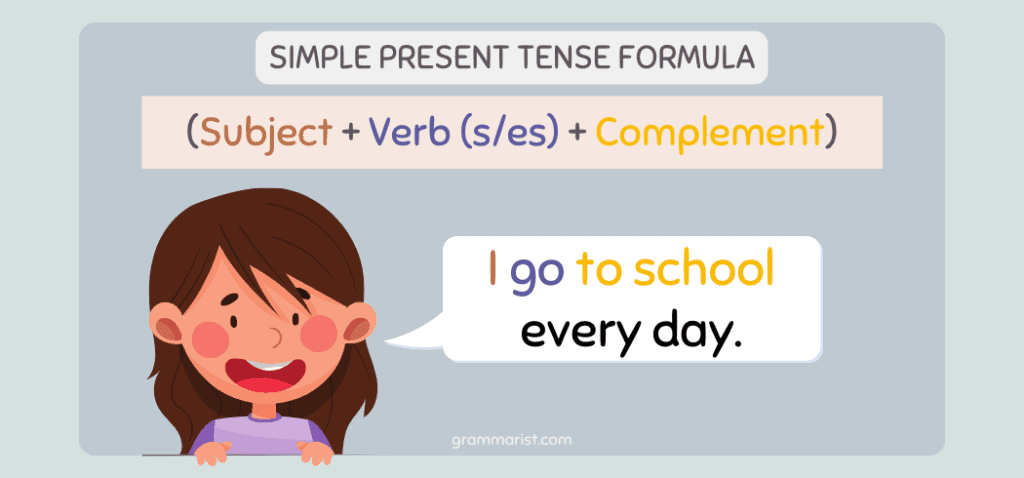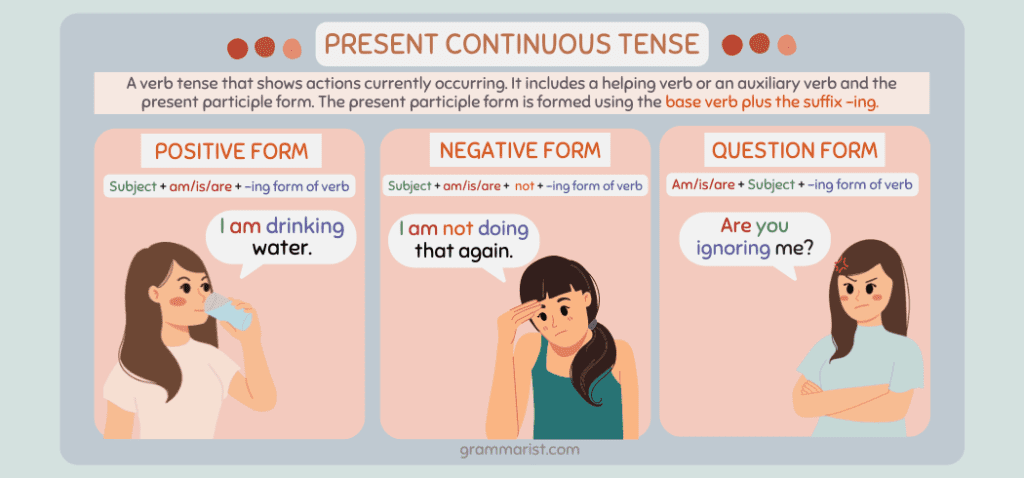Deciding between the simple present and present continuous tenses will require you to look at the time period of the action. I use the present simple form when the action is regular and permanent, while I use the present continuous form for a temporary, ongoing action.
Keep reading as I show you the differences between the two English verb tenses in terms of uses and formulas. I also created an online exercise that will allow you to master the simple present and present continuous tenses.
What is the Present Simple Tense?

In English grammar, the present simple or simple present tense is a verb tense used when the action is happening at present or when the situation happens regularly. I’ve also seen this verb tense used for permanent situations.
Most regular verbs use the root form for the simple present tense unless the subject is in the third-person singular. In this case, we add -s or -es in the end. For example:
- She practices piano every day.
The present tense verb in the sentence is practices. It ends in -s because the subject is in the third-person singular.
The formula for creating a sentence in this verb tense is:
- Subject + root verb/-s/-es form of the verb
Present simple questions require you to change the order of the subject and auxiliary verb for the formula. Here is the correct question form:
- Do/does + subject + root verb
The negative form is:
- Subject + does not + root verb
Here are more sentence examples.
- She makes it a habit to finish one book every week.
- We visit our parents every holiday.
- Do you love me?
- John does not care about his parents.
What is the Present Continuous Tense?

The present continuous or progressive tense is one of the three progressive tenses that show ongoing action at the current period of time. I’d also use it when referring to a temporary action or an incomplete action in my writing.
The present progressive form is the auxiliary verb is, are, or am plus the present participle form or -ing form of the verb. Remember to use only stative verbs for the main verb. For example:
- The professor is sending an email to the students about the type of books they need for the subject.
Affirmative sentences in the present continuous tense follow this formula:
- Subject + is/are/am + present participle form of the verb
Meanwhile, negative sentences have the following structure:
- Subject + is/are/am + not + present participle form of the verb
Here’s an example:
- She is not attending the meeting.
For present continuous questions, the correct formula is:
- Is/are/am + subject + present participle form of the verb
Here are more sentence examples:
- We are currently spending the summer holiday in Greece.
- The teachers in this distance learning institution are sending the lessons by email newsletter.
- I am not going to school.
- Is Anna sleeping yet?
- Are you currently studying?
What’s the Difference Between Present Simple and Present Continuous Tense?
Good question! There are specific rules to follow when using the simple tense and continuous tense. Let’s look at the differences between the functions and guidelines for present simple and present continuous tenses.
When to Use the Simple Present Tense
Use the simple present tense when presenting a narrative form for stories in the current period. For example:
- Marilyn talks about science and math.
You can also use it for permanent actions or regular habits. For example:
- Nicole writes book reviews for a living.
- Mary bakes every Friday.
The most common time expressions to use with the simple present tense are always, generally, often, in the morning, on Fridays, every day, etc. Remember that the time expression is in a single form, which is day instead of days.
When to Use the Present Continuous Tense
Use the present continuous tense for temporary actions currently happening. For example:
- I am looking for the best language books in the bookstore.
You can make the verb form progressive when referring to annoying habits. Some time expressions you can use include constantly and always. For example:
- You are always complaining about dinner.
Some verbs can be dynamic and stative. That means you can use some verbs in the stative form in the present continuous tense. But you can only use it if it takes on the dynamic meaning of the verb. For example:
- Are you thinking about your parents?
Think is one of the mental process verbs aside from remember, wonder, and hope.
Summary of Present Simple vs. Present Continuous
This grammar guide thoroughly explained the differences between the simple present and present continuous tense. Remember that the simple present tense is for regular actions or permanent actions, while the present continuous tense is for a temporary situation.
Understanding the functions and formulas of these two English tenses will help you become a better speaker and writer. Keep practicing, and you’ll get there!